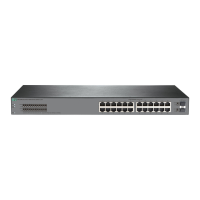35
Usage guidelines
By default, the device drops packets whose outgoing interface and incoming interface are the same.
To enable the device to forward such packets rather than drop them, configure this command in
Ethernet interface view. After the device receives a broadcast or unknown unicast packet, the device
forwards the packet through all interfaces in the VLAN to which the incoming interface of the packet
belongs.
Do not add interfaces configured with this command to an aggregation group.
Examples
# Enable bridging on GigabitEthernet 1/0/1.
<Sysname> system-view
[Sysname] interface gigabitethernet 1/0/1
[Sysname-GigabitEthernet1/0/1] port bridge enable
port up-mode
Use port up-mode to forcibly bring up a fiber Ethernet port.
Use
undo port up-mode to restore the default.
Syntax
port up-mode
undo port up-mode
Default
A fiber Ethernet port is not forcibly brought up. The physical state of a fiber port depends on the
physical state of the fibers.
Views
Ethernet interface view
Predefined user roles
network-admin
Usage guidelines
This command forcibly brings up a fiber Ethernet port and enables the port to forward packets
unidirectionally over a single link. In this way, transmission links are well utilized.
The
shutdown and port up-mode commands are exclusive with each other.
A GE fiber port forcibly brought up cannot correctly forward traffic if it is installed with a
fiber-to-copper converter, 100/1000-Mbps transceiver module, or 100-Mbps transceiver module. To
solve the problem, use the
undo port up-mode command on the fiber port.
Examples
# Forcibly bring up fiber port GigabitEthernet 1/0/1.
<Sysname> system-view
[Sysname] interface gigabitethernet 1/0/1
[Sysname-GigabitEthernet1/0/1] port up-mode
storm-constrain
Use storm-constrain to enable storm control and set thresholds for broadcast, multicast, or
unknown unicast packets on an Ethernet interface.

